The Scientist Who Discovered Sudden Oak Death Believes We Can Save the Forests
We should have taken the disease more seriously before it killed a million trees, though.
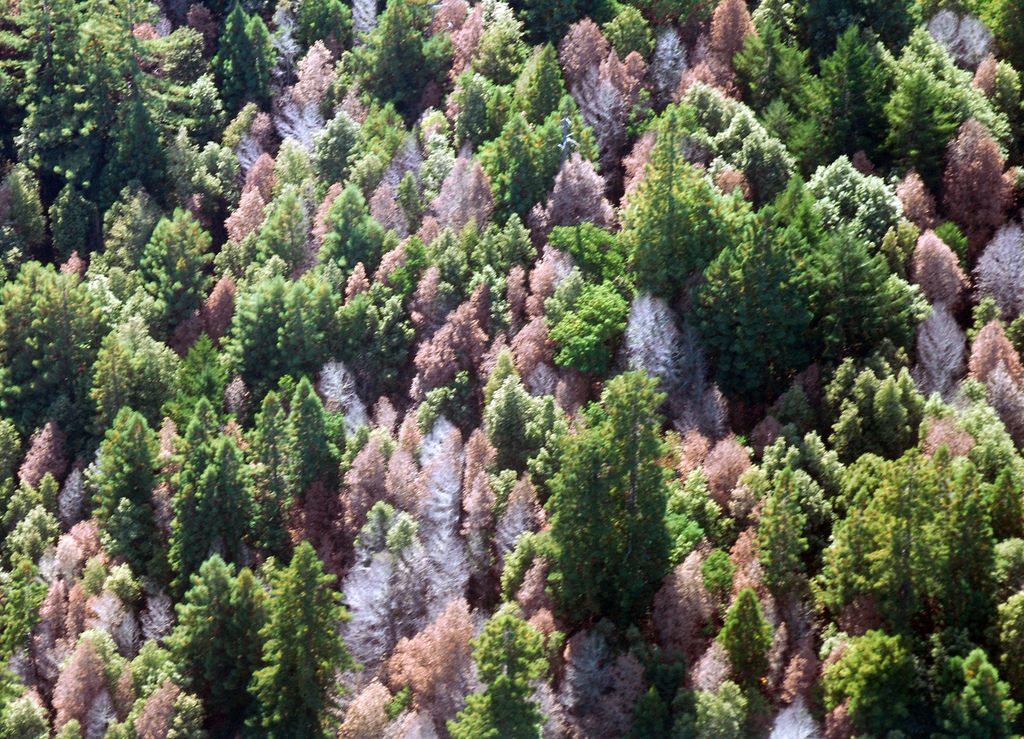
Sudden Oak death in evidence in Marin County, California. (Photo: USFS Region 5/CC BY 2.0)

In the mid 1990s, thousands of trees in California’s coastal forests began to die. Leaves turned brown very suddenly, and sap leaked from trunks, creating a forest of bleeding trees. Some were covered in insects, but no wounds or damage could be found. Later known as Sudden Oak Death (SOD), the damage caused by a microscopic pathogen began killing off over one million of California’s oak and tanoak trees rapidly, threatening whole ecosystems.

At the moment SOD seems wildly out of control, even unstoppable. But for the last 16 years, California has had an Oak Mortality Task Force, a consortium of researchers, public agencies and private interests, who learn more about the pathogen and prevent its further spread. It was difficult for the group’s first members to know where to start, though, when the state’s trees began inexplicably dying en masse. “It’s kind of a sad story,” says communications director Katie Harrell. “No one knew what was going on.”
The biggest problem was that no one suspected that a small pathogen was killing the trees; when the pathogen was first discovered in 1995, most believed that the deaths were caused by insects. Matteo Garbelotto, professor and forest pathology expert at UC Berkeley’s forest and mycology lab, was one of the first two people to discover the disease. “In the beginning it was hard, because I had just been hired by Berkeley, and the second month after I was hired I make this huge discovery,” says Garbelotto, who still studies the pathogen and ways to subdue it.
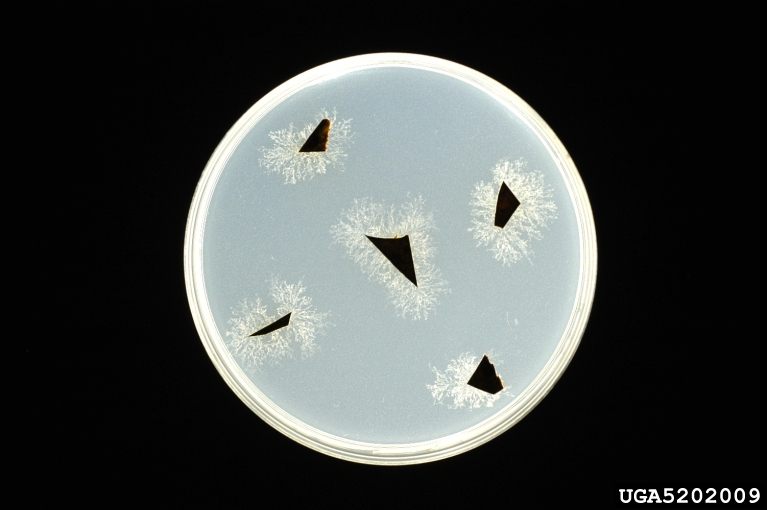
A phytophthora ramorum culture. (Photo: Jeffrey W. Lotz, Florida Department of Agriculture and Consumer Services, Bugwood.org/CC BY 3.0)
By the year 2000, Garbelotto believed that insects could not have been the culprit. Garbelotto and his lab spent over two years cultivating the pathogen in petri dishes and analyzing infected leaves before he proved his working hypothesis that not only was Sudden Oak Death caused by a pathogen, it was an entirely new species of Phytophthora, now called Phytophthora ramorum (P. ramorum).
P. ramorum is an oomycete (often called a water mold) that is distinct from molds and fungi, and is actually closely related to kelp and diatoms. It’s also more distantly related to the same pathogen that caused the Irish Potato Famine in the 1800s—and it can be as difficult to control. “What [Phytophthora in general] do normally, they do very well—and that is kill plants,” says Garbelotto. But until he discovered its attributes, scientists had a hard time understanding how P. ramorum worked; unlike other Phytophthora species, it doesn’t need water to spread during its mobile phase. Like the measles of the plant world, P. ramorum can go airborne.
The pathogen quietly attacks a tree by burrowing into the leaves or the bark. Microscopic pods called sporangia float across the air from an infected plant and land on a new leaf’s surface, in a process that sounds like it could have inspired a few science fiction films. The sporangia pod opens up at the tip. “It looks like a flying saucer with a little hatch that opens up,” says Garbelotto. The tiny UFO releases around 20 even tinier spores, which have two tails which rotate and propel the spore down to the surface of the leaf. The spore gains energy from the leaf through an attachment process that lets it penetrate the tissue; if the pathogen is nearer the tree trunk, its spores produce tubes that fit through tiny natural holes in the bark’s surface.

Evidence of phytophthora ramorum in the leaves of a tanoak. (Photo: Joseph O’Brien, USDA Forest Service/CC BY 3.0 US)
From there, the pathogen grows and expands, slowly sucking all of the nutrients and sugars away from the plant’s roots and leaves simultaneously. Oak trees excrete chemicals to kill the invader, but P. ramorum has no problem getting around the defense. The tree begins to bleed sap in a last-ditch effort, opening it up to other opportunistic pathogens and parasites, like certain tree-eating beetles and insects. Trees store their energy in dry California weather, and the disease quietly takes full advantage of them until their resources are suddenly used up—hence the name Sudden Oak Death. By the time a tree’s leaves turn brown and symptoms appear, an infected tree could have already been dead for years.
While it’s not entirely clear how or when P. ramorum came to the U.S., many people suspect it arrived via the ornamental plant trade in the 1980s (possibly from Asia, where its closest relative seems to live). Before P. ramorum, plant diseases were diagnosed by external symptoms alone. Thanks to the efforts of Garbelotto and others, the ornamental plant industry is now controlled very tightly; his lab is currently analyzing all possible plants that could contract the disease.
Headlines about the ‘unstoppable’ disease that has killed a million trees might lead the public to believe that all hope is lost—that we didn’t have the information to beat the pathogen in 2002, and now there’s nothing left to be done. This is far from accurate. Although “we don’t have a single example of an introduced forest disease that has ever been successfully eradicated,” says Garbelotto, there are indeed proven ways to lower tree deaths, stave the disease off, and prevent infections so it doesn’t get out of control.
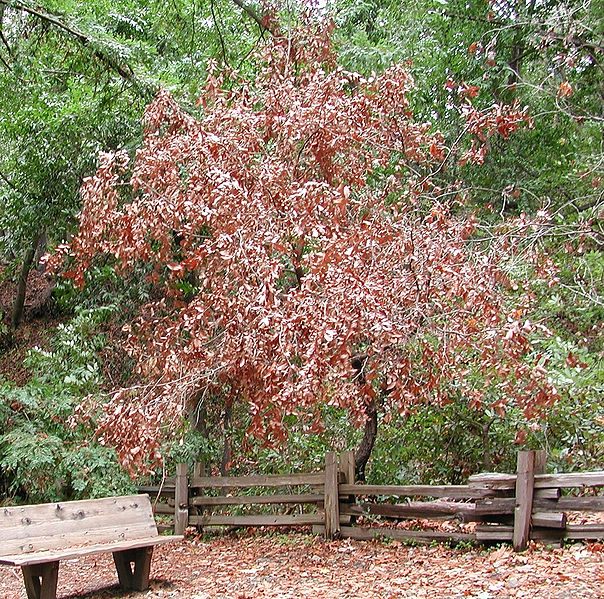
A tanoak killed by p. ramorum. (Photo: Joseph O’Brien, USDA Forest Service/CC BY 3.0 US)
What people can do to reduce Sudden Oak Death infection–and what the California Oak Mortality Task Force does–is use a tree’s natural defenses to lessen the pathogen’s prominence. For the last eight years, Garbelotto and his lab have successfully used a benign spray made of phosphites, which triggers a tree’s microbial attack response into overdrive. Even without the spray, some oak species, including juvenile tanoaks, appear to outgrow the infection during dry weather, a phenomena Garboletto and others are studying more now.
So some trees do survive–it’s all a matter of upping the trees’ survival chances, planting less susceptible trees, and keeping the pathogen away from more susceptible trees. Not moving firewood to new locations (such as campgrounds) is key. Sometimes tree removal is the answer; bay laurels in particular help P. ramorum infect other trees, similar to how mosquitoes spread disease in humans. Helpfully, the disease can only move up to 200 yards.
“In some cases, all that it takes is to remove Bay Laurels that are just a few feet away from the oak,” says Garbelotto. Though the disease will continue to spread, humans can create “a quilt, like a checkerboard, where we are going to have areas that are protected,” says Garbelotto.
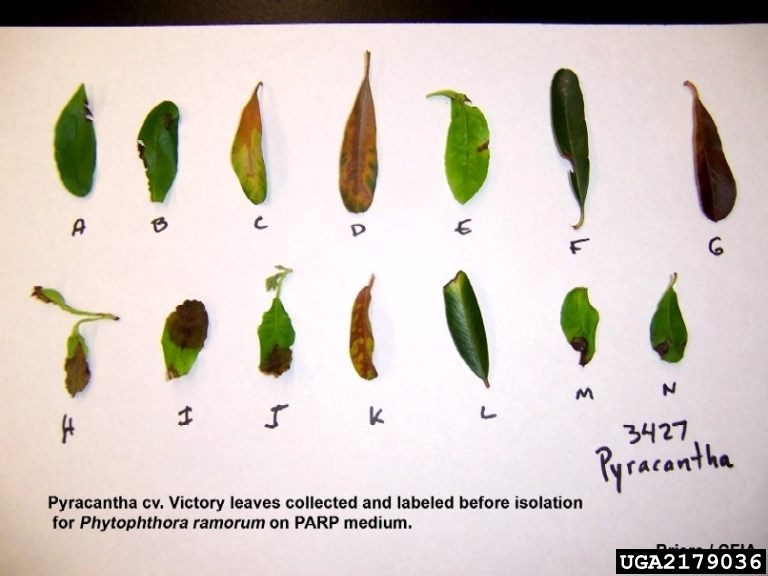
Different leaves with symptoms of phytophthora ramorum. (Photo: Cesar Calderon, USDA APHIS PPQ, Bugwood.org/CC BY 3.0)
Since infected trees are often asymptomatic, to see if the trees near you are in danger of Sudden Oak Death, both Harrell and Garbelotto recommend an app from UC Berkeley called SODMAP, which uses real samples collected by citizen scientists to locate known infected trees. The map shows the nearest infected trees in your area, allowing landowners to implement prevention tactics if their trees are at risk. The app is available on smartphones, and free to use.
Harrell says the yearly flyover surveys by the forest service will soon begin for the season. These efforts aim to monitor the forests, and try to catch new areas that have been hit; later in the year, ground troops will get a closer look at the trees. However, most treatment hinge on private efforts to control the disease by landowners, who must bear the cost of treating or removing trees themselves.
Unfortunately, the public is fickle. If a disease like SOD is visibly out of control and is threatening whole forests, we care, but as soon as the situation becomes hopeless, or conversely, seems less dire because of the silent nature of the disease, attention to it quickly wanes. “The pathogen activity ebbs and flows with water patterns, so if you have dry years, the pathogen isn’t doing much [visually],” says Harrell. “It’s hard to keep people focused on an issue when it’s not in their face.”
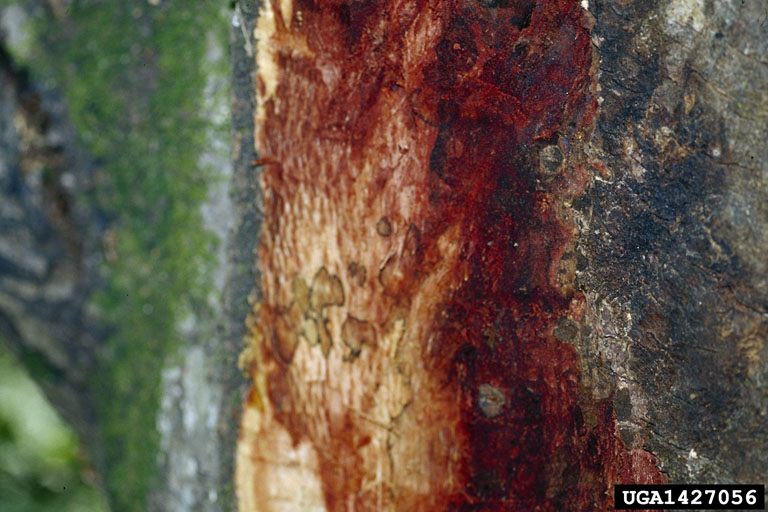
Lines of p. ramorum on a coast live oak. (Photo: Joseph OBrien, USDA Forest Service, Bugwood.org/CC BY 3.0)
If people don’t continue the fight, however, the situation could become urgent. “The reality is, another side effect of not doing anything is that [the pressure of infection] can facilitate jumping over to new hosts,” says Garbelotto. He points out that P. ramorum might already be capable of infecting other species, and that it’s unknown how it will interact with new ecosystems. It’s not just about saving the oaks and tanoaks; it’s about preventing that pathogen from experimenting with other plants and crops.
And that makes Sudden Oak Death more than an issue for forest preserves in secluded areas. It’s also a human problem. Our ability to subdue Sudden Oak Death is less about what we didn’t do or know in the past, and more what we’re willing to do now, even on a small scale.
“That’s kind of my hope,” says Garbelotto. “I know the disease is going to get worse and worse–it’s going to occupy more land, but I’m hoping there are going to be communities that [fight the disease]…that’s what’s going to give us these pockets of higher survival.” The message is clear: if we’re willing to put up the fight, our forests might stand a chance. The trees can’t do it alone.





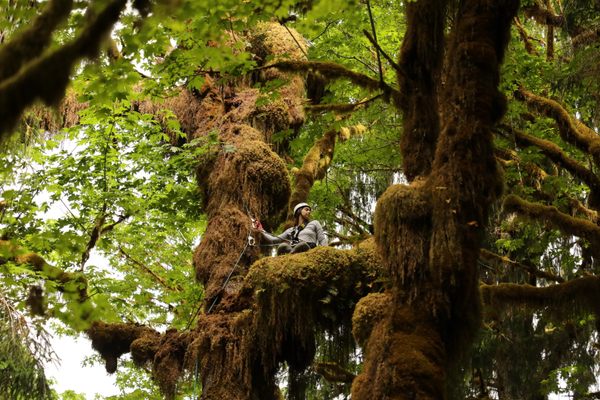













Follow us on Twitter to get the latest on the world's hidden wonders.
Like us on Facebook to get the latest on the world's hidden wonders.
Follow us on Twitter Like us on Facebook